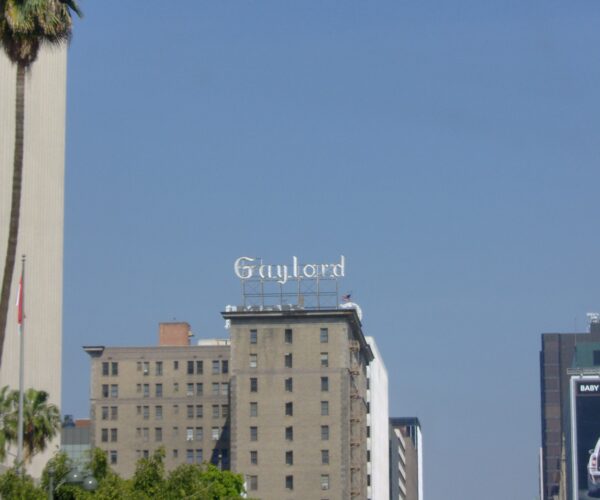
Place
Apple Tower Theatre
The Tower Theatre opened in 1927 and was the first theatre designed by renowned theatre architect S. Charles Lee. The creative designer fit 900 seats and ground floor retail onto a tiny corner lot. In June 2021, the Tower Theatre was adaptively reused and reopened as a new Apple store.
Place Details
Address
Get directions
Architect
Year
Style
Decade
Property Type
Attributes
Community

Photo by Andrew Leeson
The Tower Theatre, at S. Broadway and W. 8th Street, was commissioned by H.L. Gumbiner, who later built the Los Angeles Theatre in 1931. It was the first theater designed by architect S. Charles Lee.
The theatre was designed in Renaissance Revival style with innovative French, Spanish, Moorish, and Italian elements, all executed in terra-cotta. Its interior was modeled after the Paris Opera House. Its exterior features a prominent clock tower, the very top of which was removed after an earthquake.
The Tower was the first film house in Los Angeles to be wired for talking pictures and opened in 1927 with the silent film The Gingham Girl starring Lois Wilson and George K. Arthur. It was also one of the first theatres to use the Carrier mechanical air-conditioning system, a groundbreaking innovation in its time.
In 1950, the theatre began a successful period of running only newsreels, aptly taking on the name Newsreel Theatre. That signage can still be faintly seen on the north and east sides of the building. It also served as a general-run theatre under the name Music Hall Downtown.
In 1965, the theatre was renamed the Tower Theatre. During the 1990s, the Tower became a popular location for film production, including the Warner Bros. film Mambo Kings.
The Tower Theatre had been vacant for several decades and deteriorated when a plan to adaptively reuse the space as an Apple store emerged in 2018.
The project’s scope was comprehensive, including seismic strengthening, reconstruction of the previously removed clock tower, restoration of glazed architectural terra-cotta cladding, restoration of marquees on Broadway and 8th St., and restoration of all interior marble, plaster, and decorative painting. Structural improvements required the cataloging, removal, storage, and reinstallation of substantial areas of original interior decorative plaster. Throughout the building, “hidden” compartments retain the unreplaced historic material. Even the historic projector room, though not readily accessible, is still intact. The projection portals from the upper balcony level are still visible yet closed off. Along the stairway, to the basement, and in the lower level hallway, there is a gallery space that provides an educational showcase with historic photos and examples of the restoration process.
Adapting the historic Tower Theatre for a new use required a delicate balance. The Conservancy is pleased to see this long-vacant theatre reactivated on historic Broadway. The project team engaged the Conservancy as well as the L.A. Historic Theatre Foundation and the L.A. City Planning’s Office of Historic Resources to review proposed plans and ensure important character-defining features were retained as part of this project. We applaud Apple and theatre owners, the Delijani family, for their commitment to preservation, attention to detail, and telling the Tower Theatre story—all while reinvigorating a beautiful place that Angelenos can once again marvel at and enjoy!
The public could once again experience the interior of the Tower Theatre when the project was completed in 2021.
In 2022 the Conservancy recognized the Apple Tower Theatre’s innovative adaptive reuse project with a 2022 Preservation Award.
2022 Celebration Video
The L.A. Conservancy celebrated the 2022 Preservation Awards winners at the historic Los Angeles Memorial Coliseum with a video showcasing their stories. The program celebrated their hard work, dedication, and achievement. We’re thrilled to share Apple Tower Theatre inspiring story with you.


